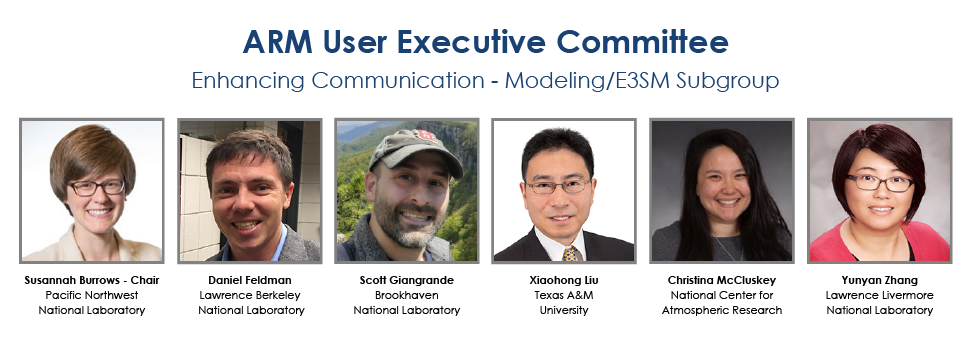From the User Executive Committee (UEC) Subgroup Chairs: June 2022
Published: 27 June 2022
Editor’s note: In 2021, the ARM User Executive Committee (UEC) created four subgroups to continue previous work and start new efforts to broaden community outreach. In a four-part series of blogs, each subgroup chair will introduce their subgroup, share their subgroup’s ideas and recommendations to ARM, and ways in which the ARM community can engage with subgroup members. Here, Susannah Burrows introduces the subgroup for enhancing communication with the modeling and Energy Exascale Earth System Model (E3SM) communities.
Part of ARM’s mission is to provide measurements that can be used in improving understanding of Earth’s climate. However, bridging the gap between measurements and the global climate and earth system models that are key tools for understanding changes in Earth’s climate represents a perennial challenge, and the bridge between observations and modeling remains very much “under construction.”
As part of its 2020 triennial review, ARM was asked to develop strategies for establishing a bridge between observations and numerical modeling, especially to the U.S. Department of Energy’s E3SM project. In response, the UEC formed a subgroup of experts to provide recommendations to ARM regarding how the user facility can effectively work with modeling centers. The subgroup was also tasked with recommending approaches that would help enable more effective use of ARM data in current and future model development efforts.

The subgroup first identified key obstacles that limit the use of ARM data in global modeling. A key challenge is temporal- and spatial-scale mismatches and representativeness. Global models must represent the global impacts of a wide range of atmospheric processes at different spatial scales, from nanometer-scale aerosol nucleation processes up to planetary-scale processes such as the Earth’s global radiation budget. However, with current models having coarse horizontal resolutions of 50–100 kilometers, only some of these processes can be explicitly simulated.
In addition, many important processes show significant temporal and spatial variability, such as variations between different seasons or regions of the Earth. To constrain such processes, models need observations that adequately sample this variability.
Meanwhile, ARM specializes in ground-based or aircraft measurements and field campaigns that provide detailed process-level information at small scales in specific locations and for short periods of time (e.g., seconds to days). These small-scale measurements can be used to improve understanding of physical atmospheric processes that are globally important, but care needs to be taken in the experimental design to ensure that the results will be useful and representative of the processes being studied.
Recommendations to ARM
Scientists have used a variety of strategies to derive insights from the detailed local-level observations that inform our understanding of climate and constrain key climate-relevant processes. For example, local observations can be used to develop a new fundamental understanding of processes that can be incorporated into parameterizations in global climate models. The observations can also be used to measure or constrain the values of specific model parameters.
In addition to these approaches, the UEC subgroup identified additional potential strategies and practical steps that could be taken and included these in recommendations.

In particular, the UEC sees opportunities for synergies between ARM observations and newly developing model capabilities and model analysis tools. These include the regionally refined (~25 km) and high-resolution (~3 km) doubly periodic versions of E3SM, which can be used to apply global model parameterizations at local to regional scales.
In addition, the subgroup encourages continued efforts to integrate ARM measurements into analysis packages such as E3SM-diags, which are used for operational benchmarking of global model fidelity. This ensures that these data sets can be effectively and routinely leveraged during model evaluation efforts.
Finally, the subgroup encourages ARM to consider further opportunities to integrate their measurements with spatially representative measurement networks. The subgroup also suggests that ARM consider adding long-term measurement support to constrain atmospheric and land-atmosphere processes that are persistent sources of uncertainty in gross and regionally refined measures of earth system model skill. This pertains not just to E3SM, but also across the international ensemble of earth system models, such as contributors to CMIP6.
ARM recently took concrete steps in this direction with the addition of the Southern Great Plains atmospheric observatory to the IMPROVE aerosol measurement network. Also, ARM now routinely monitors ice-nucleating particle concentrations alongside its established Aerosol Observing System capabilities. These detailed data sets establish a multivariate, information-rich foundation for evaluating, developing, and testing aerosol and cloud microphysical process parameterizations in global climate and earth system models.
Share Your Thoughts
Because of the scope, complexity, and ongoing need to bridge the gaps between observations and models (as well as observationalists and modelers), the UEC recognizes the critical importance of community input here. As such, the UEC subgroup highlighted the importance of modeler and observationalist engagement via workshops, meetings, publications, and field campaign co-design, such that interpersonal relationships can be established. Support for these engagement activities is a foundational step in building the bridge between the ARM observation and E3SM modeling communities.
ARM users are encouraged to provide input by contacting any member of this UEC subgroup (pictured above). We look forward to your input!
Keep up with the Atmospheric Observer
Updates on ARM news, events, and opportunities delivered to your inbox
ARM User Profile
ARM welcomes users from all institutions and nations. A free ARM user account is needed to access ARM data.


















